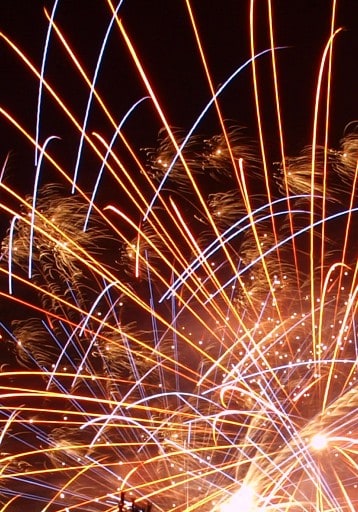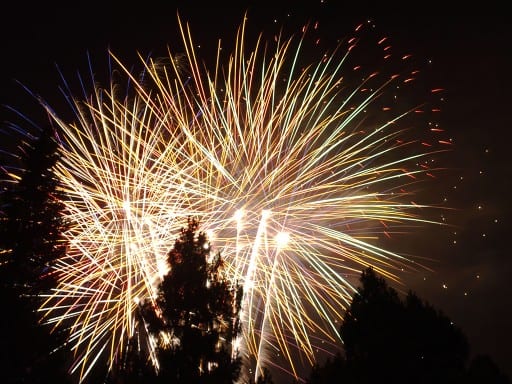So it is that time of year again, 4th of July, what other way to celebrate our Independence Day than with things that blow up filling the sky with magic beams of light! It is also a great time to bring your camera with you to capture all of that glory. Fireworks photography can be tricky if you don’t know your camera well, these tips will help you master the art of photographing the fireworks display in no time! Well, maybe not master, but get you well on the right track!
- A tripod is a necessity for photographing fireworks to mitigate excessive camera shake during longer exposures. However, you could use a rock or something to stabilize it in a pinch.
- A shutter release will greatly reduce the risk of camera shake when tripod mounted (or rock mounted). Even the slightest touch of your finger on the shutter release can induce camera shake resulting in soft or blurry fireworks shots.
 Have a good reference point. In the photo above you can see a set of trees that gives you a grounded position and a reference point. The explosions above really make them feel like they are in the air giving them that awe-inspiring sense. Although, a nice tight crop with a zoom lens could make for some excellent abstract photos as well.
Have a good reference point. In the photo above you can see a set of trees that gives you a grounded position and a reference point. The explosions above really make them feel like they are in the air giving them that awe-inspiring sense. Although, a nice tight crop with a zoom lens could make for some excellent abstract photos as well.- If you are comfortable shooting in RAW, you may want to do so with fireworks shots. You can really get the most out of them with the amount of dynamic range contained in one photo. With most JPEGS you may consider tossing them if they are over or underexposed, with a RAW file however, they are still salvageable, up to at least +/-3 whole exposure values!
- Set your ISO to something low, like 100 or 200. The longer exposures will open your sensor up to more noise in the dark areas. Of course, there are some cameras that can nail an awesome noise less photo at higher ISO’s. Take your gear into consideration and work with it from there.
- Focus you camera to infinity manually. Auto focus is a bust in fireworks situations as your camera may have difficulty “finding” something to focus on in the dark.
- I wish I could tell you the best aperture / shutter speed combo, but it is not quite that easy. Like most photography experiences, experimentation is a must. However, you do not have the time to be experimenting during a 30 minute display of fireworks, so here are my suggestions.
Method #1: The Time Release
Place your camera in full Manual Mode. Have the aperture set to something like f/4 through f/8. Have the camera set to a shutter speed of 10 seconds or so. When the fireworks start, let off the the shutter and let the camera record the full 10 seconds. The idea is to capture multiple fireworks in one shot as they are more compelling than singles. If 10 seconds is too short, set the shutter to 20 or 30 seconds.For the finale, 10-30 seconds may be too long resulting in really blown out fireworks. In that case set your shutter to something like 4 or 5 seconds. These settings are really something to experiment with on location.Method #2: The Ghost Buster
This is my favorite method of all because it makes me feel like a Ghost Buster! You know when they throw out the trap to catch a ghost they have locked into their beams, this is the exact same thing!Place your camera in Bulb setting. Bulb setting allows you to hold the shutter open as long as you deem necessary. Once you release the shutter button, the shutter closes. This method definitely requires the use of a remote shutter, if you don’t have one go with Method 1.Now when the fireworks start to shoot off, when you hear the initial boom, depress and hold the shutter. Let the shutter stay open for a couple of fireworks, 4, 5, whatever tickles your fancy, then release the shutter. You will capture all of the burst to include their trails and lit up smoke. This method require a bit of timing, but think of all of the fireworks going off as flashes from your camera. With each flash a bit more info will get recorded. Try not to hold it open too long as everything you exposed may get blown out, especially during the finale! - Last but not least… HDR and fireworks… forget about AEB, just concentrate on getting that one good exposure. You can focus on the HDR during post processing using the single exposure HDR technique, or the multiple exposures from a single RAW.










